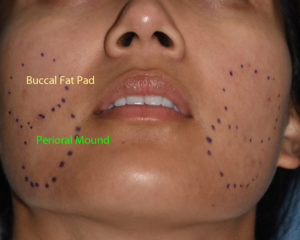Fat removal, primarily by liposuction, is a well known and effective procedure for many body areas. But when it comes to the face there are obviously much smaller volumes of fat to be removed. And there is one additional issue that the rest of the body does not have…motor nerves that can be injured. The face is full of branches of the facial nerve whose injury could have devastating facial consequences.
Thus facial sculpting by fat reduction, by its own anatomy, is a limited procedure. The size and location of the fat in the face provides limited opportunity for any significant external reduction in the shape of the face. While it is limited that does not mean it is impossible.

These two facial fat removal sites are often confused as to their location and what facial reduction effects they may have. The perioral mound area is often perceived as to the location of the buccal fat pads…or at least as to where its lower extent of that fat pad lies. These are completely different fat locations as well as have different fat cell characteristics.
The buccal fat pad is a large well encapsulated ball of fat that lies deep under the cheekbone. Its removal, while substantial, impacts the submalar region directly under the cheekbone. Its effect does not go any further south than that upper midface location in most patients. Conversely perioral mound fat is a much thinner subcutaneous fat layer whose location is south of the buccal fat pad and more at a horizontal level of the mouth.
To maximize facial fat reduction it is necessary to perform both buccal lipectomies and perioral mound liposuction.
Dr. Barry Eppley
Indianapolis, Indiana


